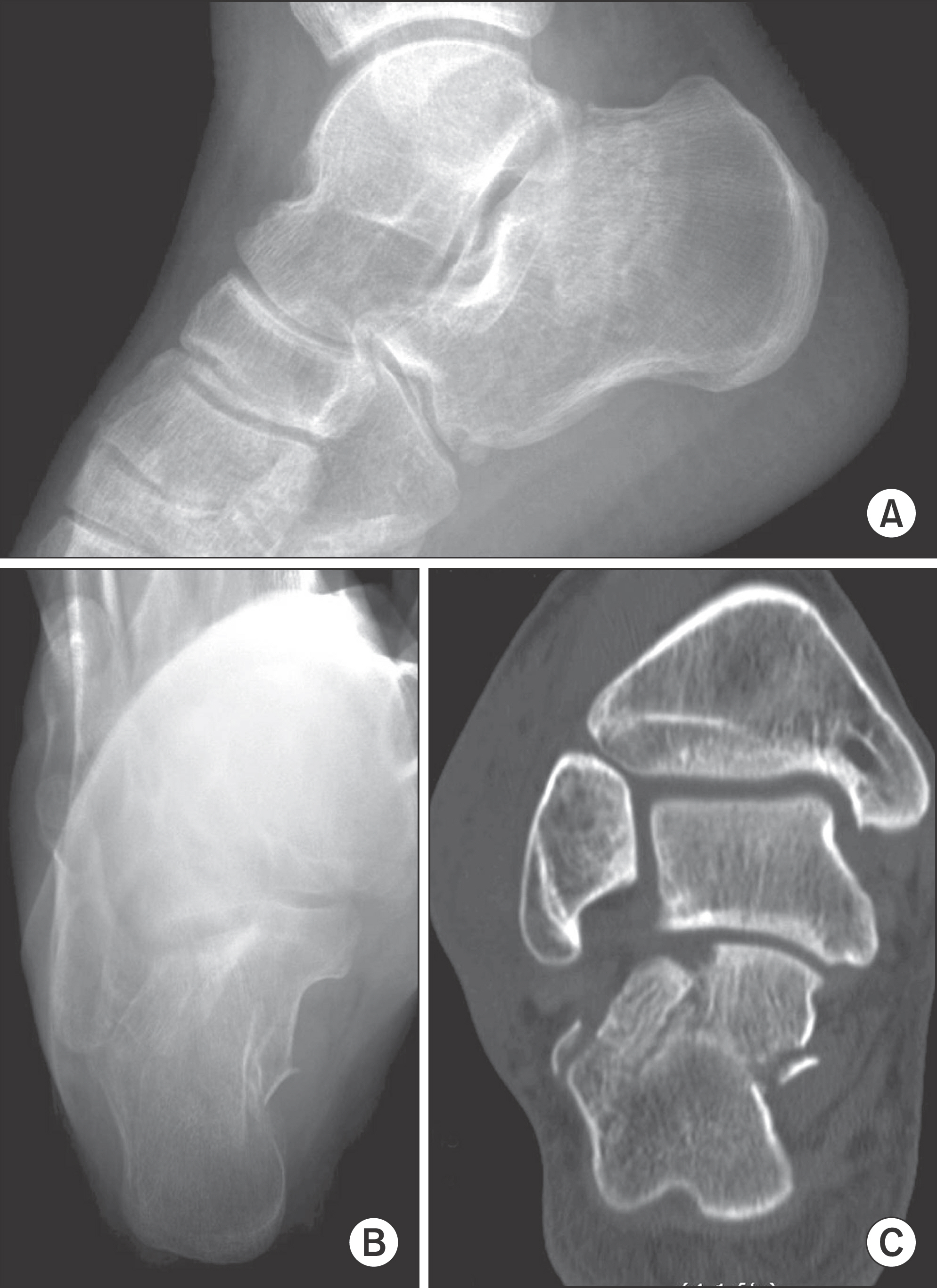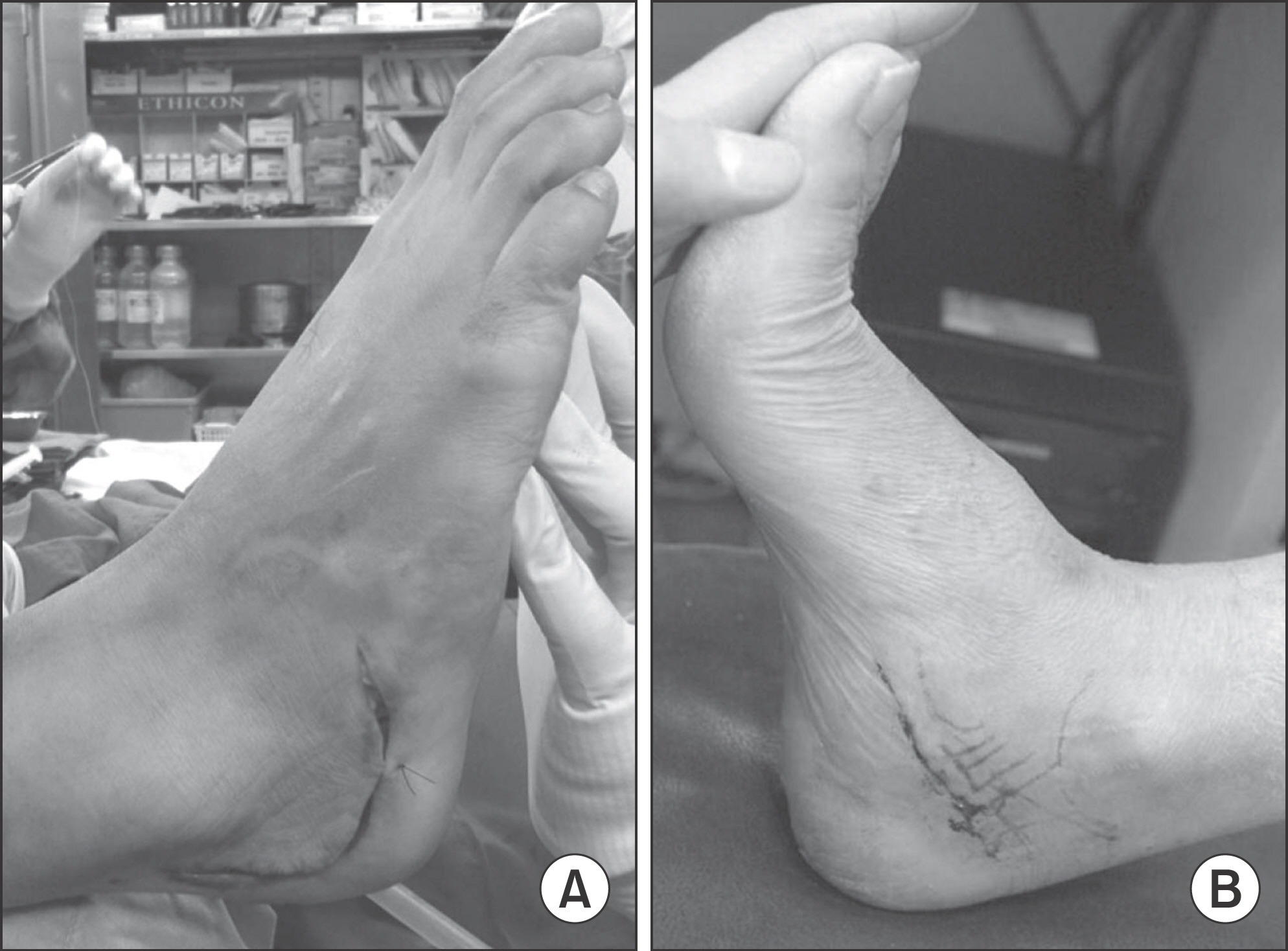J Korean Foot Ankle Soc.
2015 Mar;19(1):35-38. 10.14193/jkfas.2015.19.1.35.
Checkrein Deformity Due to Flexor Digitorum Longus Adhesion after Comminuted Calcaneus Fracture: A Case Report
- Affiliations
-
- 1Surgery of Foot and Ankle, Eulji General Hospital, Eulji University College of Medicine, Seoul, Korea. jins33@hanmail.net
- KMID: 1958704
- DOI: http://doi.org/10.14193/jkfas.2015.19.1.35
Abstract
- The checkrein deformity describes tethering of the flexor hallucis longus tendon, which mainly occurs after fracture of the distal tibia. The deformity increases with dorsiflexion of the ankle and decreases or disappears with plantarflexion of the ankle. In some cases, the deformity may occasionally include the second and third toes. In the current study, the authors experienced secondary checkrein deformity of all lesser toes after open reduction and plate fixation for comminuted fracture of the calcaneus. As a treatment, plate and screws were removed, followed by an additional medial incision which showed a partially ruptured flexor digitorum longus tendon with severe adhesion. Resection of the adhesed tendon and tenodesis of its distal portion to the flexor hallucis longus was performed for correction of the checkrein deformity. Then the lessor toe checkrein deformity recovered immediately. The authors report on this rare lessor toe checkrein deformity after calcaneal fracture fixation with a review of literature.
MeSH Terms
Figure
Reference
-
1.Carr JB. Complications of calcaneus fractures entrapment of the flexor hallucis longus: report of two cases. J Orthop Trauma. 1990. 4:166–8.2.Sanhudo JA., Lompa PA. Checkrein deformity--flexor hallucis tethering: two case reports. Foot Ankle Int. 2002. 23:799–800.
Article3.Rosenberg GA., Sferra JJ. Checkrein deformity--an unusual complication associated with a closed Salter-Harris type II ankle fracture: a case report. Foot Ankle Int. 1999. 20:591–4.
Article4.Clawson DK. Claw toes following tibial fracture. Clin Orthop Relat Res. 1974. 103:47–8.
Article5.Leitschuh PH., Zimmerman JP., Uhorchak JM., Arciero RA., Bowser L. Hallux flexion deformity secondary to entrapment of the flexor hallucis longus tendon after fibular fracture. Foot Ankle Int. 1995. 16:232–5.
Article6.Bae SY., Chung HJ., Kim MY. Checkrein deformity by incarcer-ated posterior tibial tendon and displaced flexor hallucis longus tendon following ankle dislocation: a case report. J Korean Fract Soc. 2011. 24:271–6.7.Feeney MS., Williams RL., Stephens MM. Selective lengthening of the proximal flexor tendon in the management of acquired claw toes. J Bone Joint Surg Br. 2001. 83:335–8.
Article8.Kim SH., Lee KT., Smith RW., Park YU. Checkrein deformity secondary to entrapment of FHL after talus fracture: a case report. Foot Ankle Int. 2010. 31:336–8.
Article9.Lee HS., Kim JS., Park SS., Lee DH., Park JM., Wapner KL. Treatment of checkrein deformity of the hallux. J Bone Joint Surg Br. 2008. 90:1055–8.
Article10.LaRue BG., Anctil EP. Distal anatomical relationship of the flexor hallucis longus and flexor digitorum longus tendons. Foot Ankle Int. 2006. 27:528–32.
Article
- Full Text Links
- Actions
-
Cited
- CITED
-
- Close
- Share
- Similar articles
-
- Checkrein deformity of the lesser toes following comminuted fracture of calcaneus : A Case Report
- The Checkrein Deformity of Extensor Hallucis Longus Tendon and Extensor Retinaculum Syndrome with Deep Peroneal Nerve Entrapment after Triplane Fracture: A Case Report
- Management of Checkrein Deformity
- Checkrein Deformity after Fracture
- Checkrein Deformity by Incarcerated Posterior Tibial Tendon and Displaced Flexor Hallucis Longus Tendon following Ankle Dislocation: A Case Report




